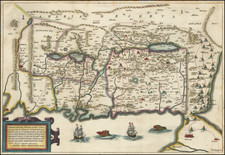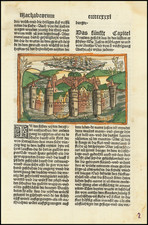Hiericho, engraved by Hartmann Schedel and published in Nuremberg in 1493, provides an illustrative representation of the Biblical City of Jericho. The depiction, from a German edition of the famed Nuremberg Chronicle, portrays the iconic walls of Jericho, accompanied by an extensive textual description elucidating its scriptural history. Moreover, this page features a depiction of Elijah's celestial ascent in a chariot, with additional portraits embellishing the verso of the map.
The late 15th century witnessed the burgeoning of the Renaissance in Europe, a period characterized by its profound revitalization of art, science, and culture. Within this context, biblical cities such as Jericho held immense significance both spiritually and historically, their stories providing a moral and historical compass for the society of the time. The Nuremberg Chronicle, in particular, stood as a seminal work, melding the realms of history, theology, and cartography.
Schedel's representation of Jericho serves as more than a mere geographic delineation; it is a testament to the intertwining of cartography and religious interpretation. Through the detailed visual portrayal, the map embodies the biblical narrative of Jericho's impregnable walls, linking historical record with spiritual teachings. The addition of Elijah's ascension further reinforces the map's theological overtones, underscoring the melding of the earthly and the divine.
The verso portraits, while not directly related to the Jericho narrative, offer insight into the broader context of religious and historical figures of importance during the era. These illustrations, interspersed with the central depiction, further enhance the map's significance, making it a rich tapestry of religious tales, historical recounting, and artistic prowess typical of the period's printed works.
The German text translates as follows:
Elijah was with his disciple Elisha when they came to the Jordan River. He struck the water with Elijah's cloak, and a path was formed, allowing them to walk through the middle. When this happened, Elijah said to Elisha that he should ask for whatever he desired before he (Elijah) would be taken away from him. Elisha asked for a double portion of his spirit, meaning the power to perform miracles and prophesy. Elijah replied that he would receive it if he witnessed him being taken away. As they spoke, a chariot of fire appeared with horses of fire. Elijah ascended to heaven on it, that is, to the earthly paradise. There he remains alive with Enoch until the time of the Antichrist, against whom he will descend to preach. Elisha cried out, "My father, my father, the chariots of Israel and its horsemen!" In the name of the cloak that Elijah had dropped for him, he returned to the Jordan, touched it with the cloak a second time, and the waters parted. He then went to Jericho and, at the request of its inhabitants, he purified the bad waters of that place with a new earthenware and a vessel with salt put inside, fresh and good. And when he later ascended towards Bethel and the children mocked him, they said, 'Ascend, baldhead!' He cursed them, and two bears tore apart forty-two of those children. This Elijah, the greatest of all prophets of his time, was taken away from people at this time. No person witnessed his end. While he lived, he performed many miracles. And as he was ablaze like a burning fire, so too were his words like a blazing torch. In the end, in the sight of Elisha, he was carried into heaven by a whirlwind, leaving behind in his place Elisha, the prophet.
The Liber Chronicarum, or Nuremberg Chronicle, is a universal history, with a strong emphasis on geography, also known as a cosmography. The work was published by Anton Koberger on a commission from the merchants Sebald Schreyer and Sebastian Kammermeister. At this time Koberger, the second printer to set up shop in Nuremberg, was at the height of his business, with as many as eighteen presses at work.
For the compilation of the Latin text, which was translated into the vernacular by George Alt, Schedel called on Medieval and Renaissance writers including Bede, Vincent of Beauvais, Martin of Tropau, Flavio Biondo, Bartolomeo Platina, Aeneas Piccolomini, and Jacobus Philippus Foresti de Bergamo. Schedel split the book into parts: Creation, the ages of Adam, Noah, Abraham, and David, the Babylonian Captivity, the life of Christ, the Antichrist, and Judgement Day, followed by a text on Poland, on Europe, and all with a final note on how the book was made. The work contains 1,804 woodcut images executed from 641-3 woodblocks by Michael Wohlgemut (1434-1519) and his stepson Wilhelm Pleydenwurff (1460-1494). Interestingly, Albrecht Durer had worked and learned in the Wohlgemut shop in the late 1480s and Koberger was his godfather.
The Chronicle appeared in 1493, with the first print run taking place between March 16, 1492 and June 12, 1493, for the Latin edition, and to December 23, 1493, for the German translation. A reduced-size (quarto) version of the book, with new illustrations, was published in several editions by Johann Schonsperger, in Augsburg, between 1496 and 1500.
The encyclopedic book includes many portraits and illustrated scenes, including the famous Dance of Death. The geographic content of the Chronicle is also notable. In addition to the double-page Ptolemaic world map and a map of Northern Europe, there are large format views of many cities including Rome, Venice, Paris, Vienna, Florence, Genoa, Salzburg, Krakow, Breslau, Budapest, Prague, Jerusalem, Alexandria, Constantinople, as well as a number of towns in what would become the German Empire.
Hartmann Schedel (1440-1514) was a physician, book collector, and writer whose most famous work, the Liber Chronicarum (Nuremberg Chronicle), included some of the first printed views of many cities in Europe and across the world.
Schedel was born and died in Nuremberg, but he also traveled for his education. From 1456 to 1463 he lived in Leipzig, where he attended the University of Leipzig and earned his MA. From there he went to Padua, where he earned a Doctor of Medicine in 1466. After university, he worked for a time in Nördlingen and then returned to Nuremberg. In 1482 he was elected a member of the Great Council of Nuremberg.
The Chronicle was published in 1493. Besides this major work, one of Schedel’s most enduring legacies is his magnificent manuscript and printed book collection, one of the largest of the fifteenth century. In 1552, Schedel's grandson, Melchior Schedel, sold about 370 manuscripts and 600 printed works from Hartmann Schedel's library to Johann Jakob Fugger. Fugger later sold his library to Duke Albert V of Bavaria in 1571. This library is now mostly preserved in the Bayerische Staasbibliothek in Munich.
Among the surviving portions of Schedel's library are the records for the publication of the Chronicle, including Schedel's contract with Anton Koberger for the publication of the work and the financing of the work by Sebald Schreyer and Sebastian Kammermeister, as well as the contracts with Wohlgemut and Pleydenwurff for the original artworks and engravings. The collection also includes original manuscript copies of the work in Latin and German.











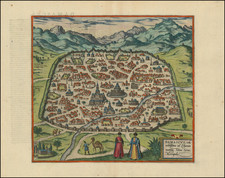
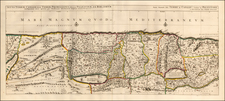
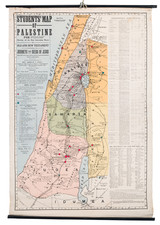
![De Gelegentheyt van't Paradys en't Landt Canaan mitsgaders d'eerst bewoonde Landen der Patriachen uyt de H. Schristure …[Shows Cyprus]](https://storage.googleapis.com/raremaps/img/small/82746.jpg)
